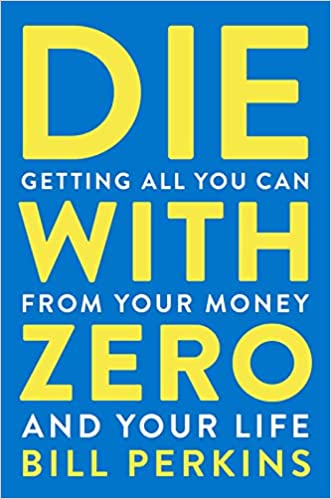Die with Zero: an argument for spending it all
What is Die with Zero?
We will all die someday. How should we use the finite amount of time allotted to us? This is the question trader, philanthropist, film producer, and high-stakes poker player Bill Perkins seeks to answer in his book, “Die with Zero.”
In this post, I’ll define Die with Zero and give an overview of Perkins’ core ideas.
Die with Zero is a philosophy that argues that we should prioritize enjoying life as opposed to maximizing wealth. Money is a means to an end, and it should be used to achieve the higher goal of a fulfilling life.
At face value, this may not seem like a groundbreaking proposition. But look closer and it’s an ardent rebuke to our culture’s conventional wisdom about spending and saving. The standard approach is to maximize wealth building in the first half of life, and fulfillment and enjoyment in the second.
Put your nose to the grindstone throughout your 20s, 30s, 40s, and 50s. A big paycheck justifies long hours and high stress. Once you hit your 60s, you can retire, begin your “golden years,” and start enjoying life.

But happiness and fulfillment, Perkins argues, is about maximizing positive experiences throughout one’s life.
“In the end, the business of life is the acquisition of memories.”
Research supports this. Studies have found that experiences provide more happiness than possessions, and that experiences continue to provide happiness through memories over time.
What these experiences are will be different for everyone. For some, it might be quality time with family: quiet mornings in the park, long walks. For others, it might be traveling around the world and exploring new places.
Regardless, most experiences do cost money so it’s up to each of us to strike a balance between earning and spending.
“My overarching goal,” Perkins says, “is to get you to think about your life in a more purposeful, deliberate manner, instead of simply doing things as you and others have always done then. Yes, I want you to plan your future, but never in a way that you forget to enjoy the present. We all get one ride on this roller coaster of life. Let’s start thinking about how to make it the most exciting, exhilarating, and satisfying ride it can be.”
Who is Bill Perkins?
Perkins studied engineering and started his career as a clerk on the floor of the New York Stock Exchange making $18,000 a year. Proud of his necessarily frugal lifestyle (he recounts living in a space “the size of a pizza oven”), he bragged to his boss about making so little and saving $1,000.
In a moment that changed his life, his boss told him that he was an idiot for saving the money. “You came here to make millions. Your earning power is going to happen. Do you think you’ll only make $18,000 a year for the rest of your life?”
This introduced Perkins to the idea of “consumption smoothing” which says that while our incomes might vary from one year to the next, our spending need not reflect those variations. We should transfer money from years of abundance into leaner years.
“Each age, Perkins writes, “tends to have a different balance of health, money, and free time. Because fulfillment requires reasonable amounts of all three, it’s a good idea at every age to trade an abundance of one (such as money) to attain more of the other two (such as buying more health or free time). Most working people focus too much on getting more money. Yet, health is more important.”
Perkins went on to a high-flying trading career, once earning his firm $1 billion over a five-year period. In what would appear to be an example of practicing what you preach, he’s dipped into philanthropy, produced multiple films, and competes in high-stakes poker tournaments around the world.
The perils of delayed gratification
My dad worked in sales for 35 years and spent his entire career saving for retirement by maintaining a rigidly frugal lifestyle. He never had new furniture, rarely took vacations, and drove old used cars. This is all fine, except for the fact that he enjoys nothing more than kicking back on his couch to watch a football game. He loves to travel. And he is and always has been deeply into cars.
He developed a strong work friendship with a friend who I’ll refer to as Jeff, who occupied the office next door. They swapped stories about odd customers, asked after one another’s kids, and commiserated about the woes of life on the road.
As they each approached retirement they talked about all the things they planned to do. The office threw them each a little party to mark the occassion, and off they went.
Their retirements were promptly interrupted by the pandemic.
One day my dad got a call. Jeff had come down with a bad cold that turned out to be COVID-19. He’d checked into a hospital a few days earlier, but the virus had already taken hold. There was nothing the doctors could do. By the end of the week, he was dead, the second half of his life forever unlived.
My dad was stricken. Even in retirement, he lived in fear of running out of money and maintained his frugal lifestyle. Jeff’s death shifted something in him. “I can’t imagine doing that miserable job for decades and never getting to enjoy the reward,” he told me.

He promptly planned a backpacking trip to the Grand Canyon and bought a Corvette. I’ve never seen him happier. I thought a lot about my dad and his friend while reading “Die with Zero.”
“Death,” Perkins writes, “wakes people up. The closer it gets, the more aware and aware we become.”
Die with Zero: 9 Principles for Living Before Dying
Here are the 9 rules that define dying with zero.
- Rule 1: Maximize your positive life experiences
- Rule 2: Start investing in experiences early
- Rule 3: Die with Zero
- Rule 4: Use all available tools
- Rule 5: Give money to your kids and/or charities thoughtfully
- Rule 6: Strike a balance
- Rule 7: Think of your life in seasons
- Rule 8: Define enough
- Rule 9: Take asymmetric risks
#1 Maximize positive life experiences
Think about the life experiences you want to have and how many times you’d like to have them.
Nothing is off the table but focus on things that will be meaningful and memorable.
#2: Start investing in experiences early
Perkins introduces the concept of a “memory dividend.”
“Experiences keep on giving in the form of fulfillment from your memories: Over time, the ongoing memory dividend can sometimes add up to more experience points than the original experience provided.”
This is an argument for having memorable experiences earlier in life. In addition, some experiences are best enjoyed at certain times. For example, if you dream of surfing off the coast of Oahu, that’s an experience best enjoyed in your 30s as opposed to your 80s.
#3: Die with Zero
Money has no value when you’re dead.
Don’t squander your life making money you don’t have the time or energy to enjoy. You’ll have needlessly wasted hours of your life that you can’t get back.
#4: Use all available tools
There is always a risk of both overspending (outliving your savings) and underspending (wasting your life by not spending enough on the things that matter). Assess your risk tolerance and adopt strategies accordingly.
#5: Give money to your kids and/or charities thoughtfully
It’s good to give to your kids, but get specific about how much, when, and why.
In general, Perkins recommends giving to kids earlier to make sure the money reaches them when it will have the maximal impact. This is not the norm. According to the Federal Reserve Board, for any income group, the age of ‘inheritance receipt’ peaks at around 60. Perkins calls this the three R’s: giving random amounts of money at a random time to random people.
Moreover, many people don’t stop to think about why they are leaving money for their kids. You might say it’s obvious: they’re kids and that’s what you do. But this is beside the point: it’s missing an opportunity to give thoughtfully.
As an example, in an interview on the Journey to Launch podcast, host Jamila Souffrant talks with Perkins about leaving an inheritance for her children. As a black woman and a child of an immigrant, leaving a financial foundation that mirrors the deep sacrifices her mother made for her carries deep meaning and significance for Souffrant and her family. This, Perkins replies, is exactly what he means.
Regarding donating to charities: it’s never too soon.
#6: Strike a balance
Die with Zero is not an argument for recklessly spending your way into bankruptcy. It’s important to strike a balance between spending on the present and saving for the future.

An important consideration is health. The ability to enjoy many experiences in life depends on health —but money plays a part, too, because a lot of activities cost money. So, spend the money when you still have health, and factor this into your calculus as you determine your approach to spending vs. saving.
#7: Think about your life in “seasons”
Create “time buckets” for different stretches of your life. Draw a timeline from now to your death and divide it into chunks of 5-10 years. Each of these intervals is a time bucket. Label them with the experiences that you want to have during your lifetime.
This is the opposite of a “bucket list” which is usually just a single list of all the things we hope to do before we die.
Creating time buckets is, in contrast to a bucket list, much more proactive and makes it easier to take money and health into account.
#8: Define enough
Determine your annual survival cost based on where you plan to live in retirement. Talk with your doctor to get a sense of your health. Think about what kinds of experiences you want to have, and when your age will begin to adversely affect your enjoyment of those activities.
Next, find the point in your life when your net worth is the highest it will ever be. This is your peak. At this point, you should begin to spend down your savings, or “decumulate” wealth. More most people this is between the ages of 45-60, when they are still in reasonably good mental and physical health. This will put you on the path to dying with zero.
#9: Take asymmetric risks
Asymmetric risks are instances in which the potential upside is much greater than the potential downside.
As I wrote about previously in relation to investing in Bitcoin, it’s sort of like asking someone out on a date. If they say no, your ego takes a hit but your life goes on. If they say yes, you could potentially be taking your future life partner out on a date. It’s (relatively) low risk, with huge potential upside.
Look for low-risk opportunities available to you that you’re not taking. Examine the fears and mindsets that may be holding you back.
Be bold, especially if you’re young. You have time on your side and can afford to take on more risk.
For inquiring minds
- Check out the book
- Perkins has a number of articles and resources on his site
- Bill Perkins interview on Jamila Souffrant’s Journey to Launch podcast: Google podcasts or Apple podcasts



One thought on “Die with Zero: an argument for spending it all”
Comments are closed.